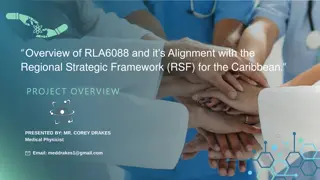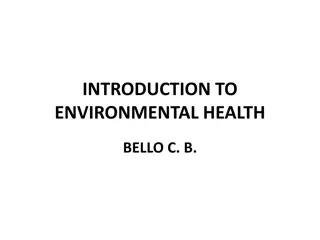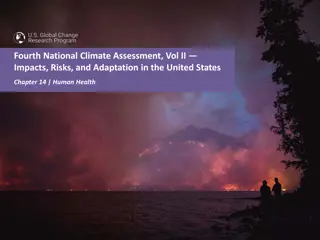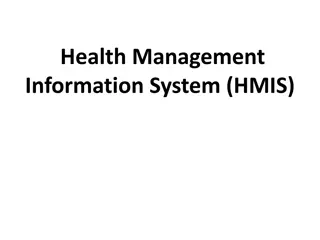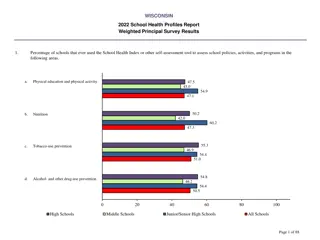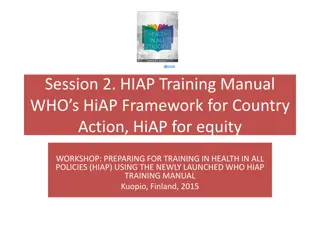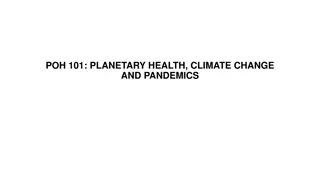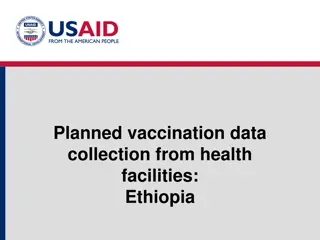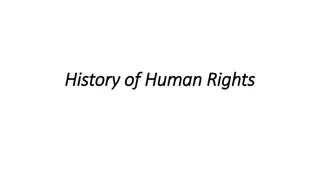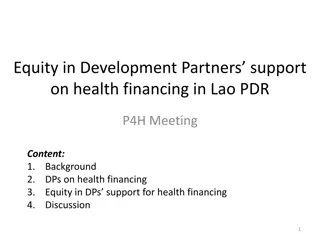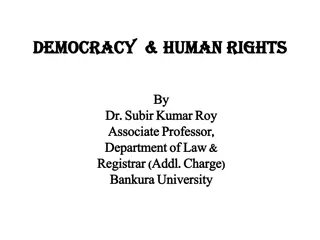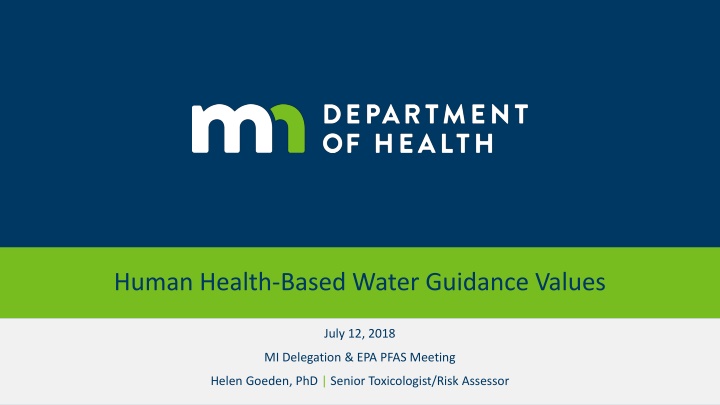
MDH Water Guidance and PFAS Health Endpoints
Explore the MDH Water Guidance values and PFAS health endpoints discussed in the July 12, 2018, meeting. Learn about the Health Risk Limits (HRL), guidance values, and re-evaluations in 2016-2017 related to PFAS compounds. Discover the standard equations used and the importance of considering non-water sources of exposure in assessing health risks.
Download Presentation

Please find below an Image/Link to download the presentation.
The content on the website is provided AS IS for your information and personal use only. It may not be sold, licensed, or shared on other websites without obtaining consent from the author. If you encounter any issues during the download, it is possible that the publisher has removed the file from their server.
You are allowed to download the files provided on this website for personal or commercial use, subject to the condition that they are used lawfully. All files are the property of their respective owners.
The content on the website is provided AS IS for your information and personal use only. It may not be sold, licensed, or shared on other websites without obtaining consent from the author.
E N D
Presentation Transcript
Human Health-Based Water Guidance Values July 12, 2018 MI Delegation & EPA PFAS Meeting Helen Goeden, PhD | Senior Toxicologist/Risk Assessor
Outline MDH PFAS Health-Based Water Guidance Types of Guidance Values 2017 Re-evaluations Summary Active area of scientific research Questions 7/12/2018 2
MDH Water Guidance 1989 Groundwater Protection Act Requires MDH to protect public health by developing human health-based values for contaminants found in Minnesota s groundwater as the result of human activity. Goal is to protect this resource as a potential source of drinking water. Health Risk Limit (HRL) a concentration of a chemical, or mixture of chemicals, that is likely to pose little or no risk to human health. [Based solely on health effects & does not consider cost, technology, etc.] HRLs are promulgated in rule. Application/use is not specified in rule but is determined by individual regulatory programs Guidance values are derived between rule promulgations: Health Based Value (HBV): are rule in waiting - follows HRL derivation methodology Risk Assessment Advice (RAA) - uncertainty, use of surrogate, or different methods 7/12/2018 3
2016 2017 Re-evaluation of Water Guidance MDH Guidance Values in 2016 Health Endpoints1 PFAS Value (ug/L) PFBA Liver and Thyroid 7 (HBV 2008, HRL 2011) [1 (2007)] PFBS Blood system, Liver, and Kidney 7 (HBV 2009, HRL 2011) PFHxS NA (PFOS as surrogate) PFOA Developmental, Liver, and Immune 0.3 (HBV 2008, HRL 2009) [0.5 (2007); 1 (2006); 7 (2002)] PFOS Developmental, Liver, and Thyroid 0.3 (HBV 2008, HRL 2009) [0.3 (2007); 0.6 (2006); 1 (2002)] 1Used in additivity (mixtures) assessments May 2016 EPA issues final Health Advisories of 70 ug/L for PFOA and PFOS MDH initiates re-evaluation of existing water guidance (PFOA, PFOS, PFBA, PFBS) 7/12/2018 4
2017 PFAS Water Guidance Health Endpoints1 Water Guidance ( g/L) 2017 Previous PFAS 7 PFBA Liver and Thyroid 7 7 PFBS Developmental, Female Repro system, and Thyroid [blood system & liver no longer listed] Kidney 3 short-term & subchronic 2 chronic PFHxS (see PFOS) (see PFOS) 0.3 PFOA Developmental, Liver, Immune, and Kidney 0.035 0.3 PFOS Developmental, Liver, Immune, Liver, and Thyroid 0.027 1Used in additivity (mixtures) assessments More information can be found at: http://www.health.state.mn.us/divs/eh/risk/guidance/gw/table.html 7/12/2018 5
MDH Water Guidance Standard HRL/HBV Equation: ?? ?????? ?? ??? RSC RfD ?? ? ?? = HBG ? IR ?? ??? RfD (Reference Dose) represents a dose at which there is little or no risk of health effects (for PFOA and PFOS this dose is best represented by a serum concentration) RSC (relative source contribution) do not want total exposure to exceed RfD so you need to account for non-water sources of exposure (e.g., diet) IR (Intake Rate) how much water someone drinks 7/12/2018 6
MDH 2017 PFOA Water Guidance RfD - represented by a reference serum concentration 2017 re-evaluation from previous still used serum concentration, but based on developmental effects + larger uncertainty factors (data suggest possibility of additional, more sensitive effects) RSC - accounting for non-water exposure 2017 from previous used recent biomonitoring data to represent non- water ( background ) exposures, allowing a large fraction to come from ingestion of water IR varies with age, much higher during infancy. Bioaccumulation presents additional (indirect) exposure concerns NEW APPROACH NEEDED?? 7/12/2018 7
Direct Exposure Concerns Impact of Bioaccumulation Potential Long half-life results in exposures, even short duration, to stay in body for years beyond period of external exposure Repeated exposures lead to accumulation (build-up) within the body Water concentrations in ppt result in serum concentrations in ppb Much higher intake rates in early-life 7/12/2018 8
Standard Approach (PFOA) Serum level allowed from water ingestion High early-life water intake Lifetime Steady- state 7/12/2018 9
Additional (indirect) Exposure Concerns Impact of Bioaccumulation Potential Long half-life results in exposures, even short duration, to stay in body for years beyond period of external exposure Repeated exposures lead to accumulation (build-up) within the body Water concentrations in ppt result in serum concentrations in ppb Much higher intake rates in early-life Accumulated levels can be transferred to offspring Placental transfer* (PFOA ~60 to 200%) *Empirical Cord:Maternal serum ratios reported in literature 7/12/2018 10
Additional (indirect) Exposure Concerns Serum level allowed from water ingestion Pre-existing body burden at birth + high early-life intake ~40% > Lifetime steady-state 7/12/2018 11
Additional (indirect) Exposure Concerns Impact of Bioaccumulation Potential Long half-life results in exposures, even short duration, to stay in body for years beyond period of external exposure Repeated exposures lead to accumulation (build-up) within the body Water concentrations in ppt result in serum concentrations in ppb Much higher intake rates in early-life Accumulated levels can be transferred to offspring Placental transfer* (PFOA ~60 to 200%) Breastmilk transfer* (PFOA ~2.6 - 12%) * Empirical Cord:Maternal serum ratios reported in literature ** Empirical Breastmilk: Maternal serum ratio reported in literature 7/12/2018 12
Additional (indirect) Exposure Concerns Must find a way to incorporate these SIGNIFICANT indirect exposure pathways Serum level allowed from water ingestion 7/12/2018 13
Model Scenarios Formula-Fed Infant Breast-Fed Infant Maternal Serum Concentration (steady state) Clearance (t ) Maternal Serum Concentration (steady state) Clearance (t ) Placental Transfer (42% PFOS/87% PFOA) Placental Transfer (42% PFOS/87% PFOA) Neonatal Serum Concentration (birth) Neonatal Serum Concentration (birth) Breastfeeding (1.3% PFOS/5.2% PFOA) Formula Fed Infant Serum Concentration (>birth to 1 yr) Contaminated Water Contaminated Water Offspring Serum Concentration (>birth to steady state) Clearance (t ) Offspring Serum Concentration (>1 yr to steady state) Clearance (t ) Clearance (t ) (t 5.4 yrs) 14
Calculating Daily Serum Concentrations ?? ???? ?? ? ?? ??? ????? ????????????? = ? ????????? ???? ?? ??? (?????/?????????? ???? ? ? ?????/?????????? ?? ? ? ? ?? ??? ????? ????????????? = ? ????????? ???? ?? ??? Where Where ? ? ?? ? ????????? ???? = ?????? ?? ???????????? ?? ??? ?? ???? ???? (?) 15
Model Parameter Values (PFOA) Model Parameter Central Tendency Value Upper Percentile Value Half-life (days) 840 (2.3 years) 1679 (4.6 years) Placental Transfer (infant:mother) MDH used a Reasonable Maximum Exposed (RME) Individual Scenario. Upper Percentile values for intake and duration + Central Tendency values for remaining parameters. 0.87 1.69 Breastmilk Transfer (milk:mother) 0.052 0.12 Breastmilk Intake1 (mL/kg-d) and Body weight2 (kg) (0-12 months of age) Mean Upper percentile Breastfeeding duration 6 months, then phased out to zero by 12 months of age 12 months Water Intake1 (mL/kg-d) and Body weight2 (kg) (0-55+ years of age) 95th percentile Mean Volume of Distribution (L/kg) 0.17 Volume of Distribution Age Adjustment 2.4 (birth) to 1.0 (age 10) 1 Age-specific intake rates were taken from EPA Exposure Factors Handbook (breastmilk- Table 15-1; water Table ) 2 Age-specific body weights were calculated from intake data 16
Incorporation of Exposure via Placental & Breastmilk Transfer (Serum ~ 65 g/L) 7/12/2018 17
Alternative Scenarios 7/12/2018 18
MDH Guidance Summary Based on protection of susceptible & highly exposed populations Protective for tap water used for drinking, cooking, showering, and other uses Cumulative additivity assessment of chemicals with similar health endpoints e.g., Liver XX g PFBA/L* + XX g PFHxS/L* + XX g PFOA/L* + XX g PFOS/L* = Health Risk Index PFBS HBV PFHxS HBG ** PFOA HBG PFOS HBG Reassessing new PFOS information (e.g., half-life) * Detected drinking water concentration **Currently using PFOS as an interim substitute Breastfeeding can be a significant exposure pathway for PFHxS, PFOS, and PFOA. However, breastfeeding is important for the short and long term health of both a mother and infant. MDH recommends that women currently breastfeeding, and pregnant women who plan to breastfeed, continue to do so. 7/12/2018 19
Very Active Area of Research MDH has revised guidance values 2 4 times as scientific knowledge changes 50 80 publications in PubMed per month ATSDR draft Minimal Risk Limits (MRLs, akin to RfDs) PFOS: 0.03 g/kg-d (2015) 0.002 g/kg-d (2018) [MDH 0.0051 g/kg-d (2017)] PFOA: 0.02 g/kg-d (2015) 0.003 g/kg-d (2018) [MDH 0.018 g/kg-d (2017)] PFNA: 0.004 g/kg-d (2018) PFHxS: 0.020 g/kg-d (2018) EFSA draft Tolerable Daily Intake (TDIs, akin to RfDs) PFOS: 0.15 g/kg-d (2009) 0.0019 g/kg-d (2018) PFOA: 1.5 g/kg-d (2009) 0.0009 g/kg-d (2018) Science-based Expect Change 7/12/2018 20
Questions? Helen Goeden Helen.Goeden@state.mn.us 651-201-4904 7/12/2018 21
Additional Slides 7/12/2018 22
Overview of PFAS Health Effects Epidemiology Studies (associations, not causal) Developmental (e.g., birth weight) Endocrine (e.g., thyroid homeostasis) Immune (e.g., vaccine response, ulcerative colitis) Kidney (e.g., uric acid) Liver (e.g., serum lipids and liver enzymes) Cancer (e.g., testicular, kidney) Laboratory Animal Studies (causal) Developmental Effects (e.g., body weight, delayed puberty & mammary gland development , accelerated puberty , changes in lipid metabolism & liver histology) Endocrine (e.g., thyroid hormones) Immune (e.g., immune response, spleen & thymus weight) Kidney (e.g., organ weight) Liver (e.g., cholesterol, organ weight, evidence of cellular damage) Cancer? 23 7/12/2018
Reference serum levels vs NHANES MDH 2017 reference serum level = 63 ng/mL MDH 2017 reference serum level = 130 ng/mL 7/12/2018 24
Protectiveness of Direct Constant Exposure Assumption Accumulated Levels Can Lead To Significant Indirect Exposure Transferred to breastmilk (% of maternal serum: ~1-2% PFOS & ~2.6-10% PFOA) [accumulation can result in breastmilk levels >> drinking water levels] Published studies demonstrated significant breastfed infant serum levels & corresponding in maternal breast milk levels Thomsen et al 2010 25 Fromme et al 2010


